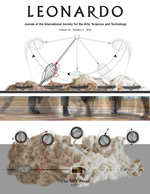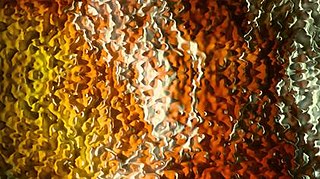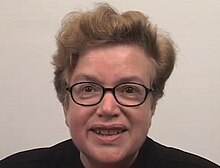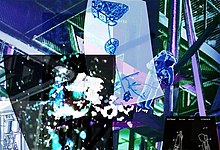Computer art is art in which computers play a role in production or display of the artwork. Such art can be an image, sound, animation, video, CD-ROM, DVD-ROM, video game, website, algorithm, performance or gallery installation. Many traditional disciplines are now integrating digital technologies and, as a result, the lines between traditional works of art and new media works created using computers has been blurred. For instance, an artist may combine traditional painting with algorithm art and other digital techniques. As a result, defining computer art by its end product can thus be difficult. Computer art is bound to change over time since changes in technology and software directly affect what is possible.
Information art, which is also known as informatism or data art, is an art form that is inspired by and principally incorporates data, computer science, information technology, artificial intelligence, and related data-driven fields. The information revolution has resulted in over-abundant data that are critical in a wide range of areas, from the Internet to healthcare systems. Related to conceptual art, electronic art and new media art, informatism considers this new technological, economical, and cultural paradigm shift, such that artworks may provide social commentaries, synthesize multiple disciplines, and develop new aesthetics. Realization of information art often take, although not necessarily, interdisciplinary and multidisciplinary approaches incorporating visual, audio, data analysis, performance, and others. Furthermore, physical and virtual installations involving informatism often provide human-computer interaction that generate artistic contents based on the processing of large amounts of data.

Critical Art Ensemble (CAE) is a collective of five tactical media practitioners of various specializations including computer graphics and web design, film/video, photography, text art, book art, and performance. For CAE, tactical media is situational, ephemeral, and self-terminating. It encourages the use of any media that will engage a particular socio-political context in order to create molecular interventions and semiotic shocks that collectively could diminish the rising intensity of authoritarian culture.

Frank Joseph Malina was an American aeronautical engineer and painter, known for his pioneering work in early rocketry.
George Gessert is one of the best-known artists in the contemporary art movement known as bio-art a/k/a BioArt. Gessert began his career as a painter and printmaker, and began breeding plants as an art form in the late 1970s. Beginning in the 1980s, Gessert's work focused on the overlap between art and genetics, and he has exhibited a series of installations of hybrids and documentation of breeding projects.
BioArt is an art practice where artists work with biology, live tissues, bacteria, living organisms, and life processes. Using scientific processes and practices such as biology and life science practices, microscopy, and biotechnology the artworks are produced in laboratories, galleries, or artists' studios. The scope of BioArt is a range considered by some artists to be strictly limited to "living forms", while other artists include art that uses the imagery of contemporary medicine and biological research, or require that it address a controversy or blind spot posed by the very character of the life sciences.

Leonardo is a peer-reviewed academic journal published by the MIT Press covering the application of contemporary science and technology to the arts and music.
Cybernetic Serendipity was an exhibition of cybernetic art curated by Jasia Reichardt, shown at the Institute of Contemporary Arts, London, England, from 2 August to 20 October 1968, and then toured across the United States. Two stops in the United States were the Corcoran Annex, Washington, D.C., from 16 July to 31 August 1969, and the newly opened Exploratorium in San Francisco, from 1 November to 18 December 1969.

Hybrid art is a contemporary art movement in which artists work with frontier areas of science and emerging technologies. Artists work with fields such as biology, robotics, physical sciences, experimental interface technologies, artificial intelligence, and information visualization. They address the research in many ways such as undertaking new research agendas, visualizing results in new ways, or critiquing the social implications of the research. The worldwide community has developed new kinds of art festivals, information sources, organizations, and university programs to explore these new arts.

New media art includes artworks designed and produced by means of electronic media technologies. It comprises virtual art, computer graphics, computer animation, digital art, interactive art, sound art, Internet art, video games, robotics, 3D printing, immersive installation and cyborg art. The term defines itself by the thereby created artwork, which differentiates itself from that deriving from conventional visual arts such as architecture, painting or sculpture.

Ricardo Mbarkho, is a Lebanese contemporary artist, researcher, and assistant professor.
Cybernetic art is contemporary art that builds upon the legacy of cybernetics, where feedback involved in the work takes precedence over traditional aesthetic and material concerns. The relationship between cybernetics and art can be summarised in three ways: cybernetics can be used to study art, to create works of art or may itself be regarded as an art form in its own right.

Victoria Vesna is a professor and digital media artist. She is known for her feminist video, computer and internet art and has been active since the early 1980s. Along with collaborator Jim Gimzewski she is thought to have created one of the first interactive artworks related to nanotechnology and defines her art practice as experimental research.
Nina Sellars is an artist and Research Fellow at the Alternate Anatomies Lab, School of Design & Art, Curtin University, Perth, Australia. Sellars describes her artwork as focused on "human anatomy and its symbiotic history with arts and technology." Sellars is also an Adjunct Lecturer at the Department of Anatomy & Developmental Biology, Monash University, Melbourne, Australia and the Project Manager for Immersive Environments at the School of Design & Art, Curtin University, where she designs augmented reality/blended reality teaching spaces that are informed by visual arts practice.

Sonia Landy Sheridan, known as Sonia Sheridan, was an American artist, academic and researcher, who in 1969 founded the Generative Systems research program at the School of the Art Institute of Chicago. She was honorary editor of Leonardo, the Journal of the International Society for the Arts Sciences and Technology (Leonardo/ISAST). Sheridan had received awards from numerous institutions, including the Guggenheim Foundation in 1973 for Photography and the National Endowment for the Arts.

Nina Czegledy is a Canadian artist, new media art curator and writer.
Suzanne Anker is an American visual artist and theorist. Considered a pioneer in Bio Art., she has been working on the relationship of art and the biological sciences for more than twenty five years. Her practice investigates the ways in which nature is being altered in the 21st century. Concerned with genetics, climate change, species extinction and toxic degradation, her work calls attention to the beauty of life and the "necessity for enlightened thinking about nature's 'tangled bank'." Anker frequently assembles with "pre-defined and found materials" botanical specimens, medical museum artifacts, laboratory apparatus, microscopic images and geological specimens.
Leonardo, The International Society for the Arts, Sciences and Technology (Leonardo/ISAST) is a registered 501(c)(3) nonprofit formed in 1982 as an umbrella organization for the journals Leonardo and the Leonardo Music Journal. In 2018, Leonardo/ISAST was awarded the Golden Nica Prix Ars Electronica as Visionary Pioneers of New Media Art.

Patricia Olynyk is a Canadian-born American multimedia artist, scholar and educator whose work explores art, science, and technology-related themes. Known for collaborating across disciplines and projects that explore the mind-brain relationship, interspecies communication and the phenomenology of perception, her work examines "the way that experiences and biases toward scientific subjects affect interpretations in specific contexts."
Linda Dalrymple Henderson is an American art historian, educator, and curator. Henderson is currently the David Bruton, Jr. Centennial Professor in Art History Emeritus at the University of Texas at Austin. Her research focuses on modern art, specifically twentieth-century American and European art.











